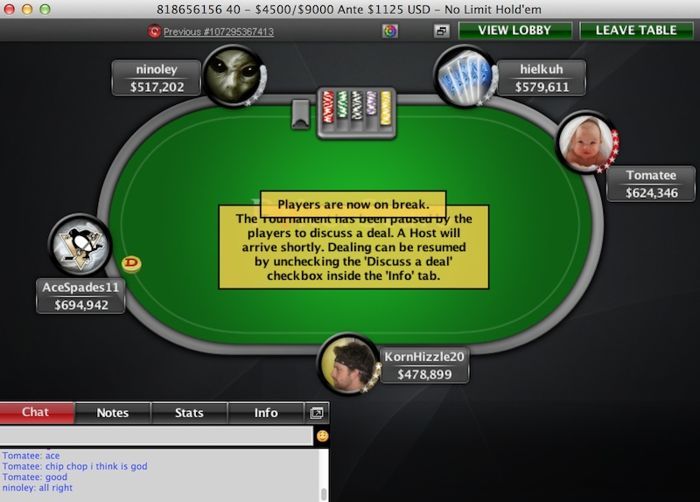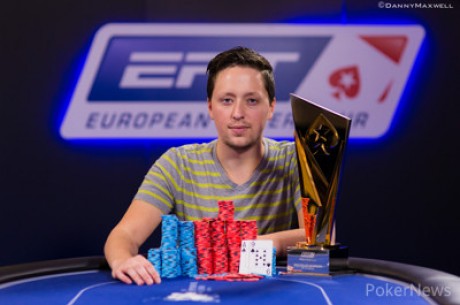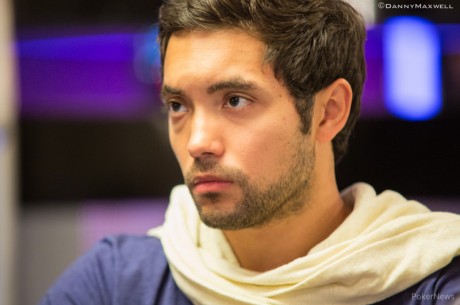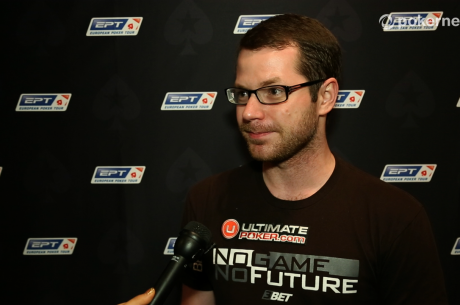Let��s Make a Deal: Introducing Deal-Making in Tournaments

A hand of poker is kind of like a negotiation, although it isn��t necessarily clear until the hand concludes who is the seller and who is the buyer.
Say you and I are playing a hand of no-limit Texas hold��em. You are dealt K?K? in late position and raise, and I call you from the big blind with Q?J?. The flop comes queen-high �� Q?7?2? �� and I check-call your continuation bet. The turn is another low card, say the 3?, and again I check.
You have a good read on me and feel pretty confident that not only are your pair of kings better than whatever I have, but that I seem to be a calling station and willing to keep calling you with my second-best hand. The way the hand has evolved, you��re now a seller and I��m a buyer, although in truth neither of us is 100% sure of our respective roles as yet.
As you gather chips to bet this turn, you are trying to think of a good price to set. Charge too much and I��ll back out of the deal. Charge too little and I��ll get to buy a look at the river too cheaply.
We could find other examples of this sort of negotiation happening in a poker hand �� such as when two players each with big hands before the flop raise and reraise back and forth, or when a player with a busted flush draw after the river is dealt makes a big bet with ace-high and tries to ��sell�� an idea (the false one that he or she has a big hand) and bluff an opponent into folding.
But you get the idea... we��re doing a lot of ��buying�� and ��selling�� in the hands we play against each other, constantly setting prices on the value of our cards, both real and perceived, and making purchases with our bets.
I bring up this analogy in order to introduce the topic of deal-making at the end of poker tournaments. I��m referring to the situation that happens quite a lot in live poker tournaments, even low buy-in ones, and also in certain cases online, when just a few players are left and discussions begin to try to divide up the remaining prize money in some fashion other than would happen if the tournament were played out without a deal.
In this three-part series I��d like to (1) introduce tournament deal-making; (2) talk about methods commonly employed for handling these end-of-tourney ��negotiations��; and (3) discuss reasons for and against making such deals to ��chop�� prize money at the end of tournaments.
Final table deals and minimizing risk
The art of making such end-of-tourney deals might seem like a completely different ��game�� than the one players have been playing up to that point. But I��m suggesting that in reality the negotiations during a deal aren��t too terribly different from the negotiations that have been occurring hand after hand in the tournament.
Sometimes in deals there��s little or no ��haggling,�� such as in a hand when a player just calls down another or folds to a bet or raise without much fuss. Other times there��s a lot of ��gamesmanship�� and back-and-forthing in deals, like in a more complicated hand involving a lot of guesswork and ��leveling�� with players testing each other more thoroughly.
The recently-concluded MicroMillions 6 series on PokerStars kind of highlighted the fact that sometimes players get involved in deal-making without really knowing how to play that ��game�� as well as they play the game of poker. Given the nature of the MicroMillions �� with its tiny buy-ins and big payouts �� it��s not uncommon to see players at final tables without a lot (or any) experience with deal-making suddenly find themselves in the middle of doing just that. Indeed, sometimes players don��t appreciate how they need to be thinking actively and be ready to negotiate during the deal-making process just as much as when they play a poker hand.
A quick check through the results shows that 55 of the 100 tournaments in this year��s MicroMillions 6 ended in final table deals that saw the prize money being divided among the final few players. Some of these deals came at heads-up with just the last two players making them, while others came earlier and involved multiple players.
For instance, in Event #13, a $3.30 seven-card stud tournament, there were six players left when one of them suggested a ��chop�� and the others all agreed to discuss the subject.
At the time there was more than $8,300 still left in the prize pool, with $2,623.92 of it scheduled to go to the winner and just $466.12 to the player finishing sixth. But the players negotiated a different set of payouts that saw all of them guaranteed prizes ranging from about $1,720 down to about $1,125, with $200 being set aside to go to the winner so as to give them something still for which to play.
In that case �� and indeed, in the case of many deal-making situations �� the limits had risen so high in the tournament that players wished not to gamble on catching enough hands to avoid going out in sixth place. Making the deal assured all six of them they��d be paid handsomely with four-figure prizes for their tiny $3.30 investments.
When the final table deal becomes the ��final hand��

On PokerStars, it is often required that when players make deals at the end of a tournament they are forced to set a little bit of the prize pool aside to go to the winner. Such is always the case in the MicroMillions tournaments and all of the ��COOP�� events (WCOOP, SCOOP, TCOOP), as well as in the big, popular weekly tournaments on the site like the Sunday Million and the Super Tuesday. That screenshot to the left was taken during a five-way discussion of a possible deal at the end of last week's Super Tuesday on PokerStars.)
However, in some cases there is no requirement to set aside any of the remaining prize money if a final table deal is made. For example, over the last few days PokerNews has been reporting from the 2013 Seneca Niagara Fall Poker Classic, and in the $500 NLHE Re-Entry event the final four players made a deal to divide the remaining prize money �� leaving none of the prize pool to the side �� and when the deal was made the tournament was stopped right there with no more hands being played.
In that case there was $27,427 left in the prize pool with $11,765 scheduled to go to the winner and just $3,493 to the player finishing fourth. But the remaining players decided to lessen the differences between the scheduled payouts and give $9,127 to then chip leader Rick Block, $7,500 to Budway Salhab who was second in chips, and $5,400 apiece to Tom Urbanski and Eric Gierlinger who at the time were close in chips in third and fourth.
By the way�� peek up at that photo above, Block��s winner photo from the Seneca Niagara Fall Poker Classic $500 NLHE Re-Entry. See how he is holding up a couple of aces as his winning hand? In reality there was no final hand as play concluded with the deal, but it was suggested to him he hold up a hand for the photo, anyway. And after all, we all like the look of a couple of aces, so they do make the picture even nicer.
It might seem kind of anticlimactic for a tournament to end without a final hand being dealt. It would be sort of like if in that hand I was describing up above �� the one in which you had K?K? and I had Q?J? on that Q?7?2?3? board �� we decided not even to bother with the river card and instead just split whatever was in the middle with me letting you have most of it since you had such a big edge in the hand at that moment.
According the PokerNews Poker Odds Calculator, I��ve only got an 11.36% chance of hitting a lucky river card to win the hand. But pretend there��s $100 in the middle and you say ��Let��s forget the river card �� you take $25 and I��ll take $75.�� I��ll accept the deal to avoid getting less than $25 (i.e., zero). And you offered it for the same reason �� i.e., to avoid getting less than $75 in the hand, which could happen if I get lucky.
Of course, that sort of thing doesn��t really happen in individual hands �� although there is such a thing as ��taking insurance�� in a hand which is kind of a related idea. But the same principle is being followed when deals are made at the end of a tournament, with players who make deals being motivated by a desire to avoid letting bad luck at the end of a tourney significantly lessen the amount they earn.
In that Seneca Niagara tourney, Block had a big chip lead and therefore had the best chance of winning the $11,765 first prize with four players left. But there was also a slim chance he could finish fourth and get just $3,493, so he found it prudent to accept the $9,127 offered to him by the other three players and remove all doubt about how he��d end up.
Getting started with deal-making
So that��s what final table deals are, but how do players come up with these alternate figures for payouts at the end of a tournament? Where do such negotiations start? How do players know what to ask for when the deal-making begins?
Tomorrow I��ll be back with some discussion of a couple of frequently used methods for making end-of-tournament deals �� (1) the ��chip count�� (or ��chip chop��) method, and (2) the ��ICM�� or Independent Chip Model method. Both are commonly utilized on PokerStars and other online sites when it comes to final table deals, and for those who play a lot of tournaments it��s worth at least being somewhat familiar with the significant differences between the two methods.
Get all the latest PokerNews updates on your social media outlets. Follow us on Twitter and find us on both Facebook and Google+!








